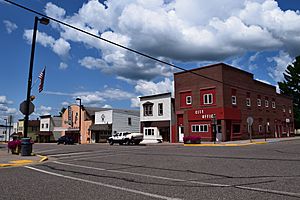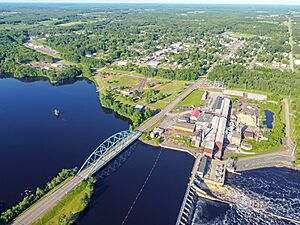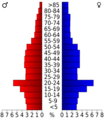Cornell, Wisconsin facts for kids
Quick facts for kids
Cornell, Wisconsin
|
|
|---|---|

Downtown Cornell
|
|

Location of Cornell in Chippewa County, Wisconsin.
|
|
| Country | |
| State | |
| County | Chippewa |
| Area | |
| • Total | 4.32 sq mi (11.19 km2) |
| • Land | 3.79 sq mi (9.81 km2) |
| • Water | 0.54 sq mi (1.38 km2) |
| Elevation | 1,083 ft (330 m) |
| Population
(2020)
|
|
| • Total | 1,453 |
| • Density | 336.3/sq mi (129.85/km2) |
| Time zone | UTC-6 (Central (CST)) |
| • Summer (DST) | UTC-5 (CDT) |
| Area code(s) | 715 & 534 |
| FIPS code | 55-17100 |
| GNIS feature ID | 1563404 |
Cornell is a small city in Chippewa County, Wisconsin, United States. In 2020, about 1,453 people lived there. The city is located on the Chippewa River. It is found upstream from Lake Wissota and Chippewa Falls. Two main roads, Highway 64 and Highway 27, cross the river in Cornell.
Contents
History of Cornell
For a long time, the area around Cornell was visited by Sioux and Chippewa people. They traveled along the Chippewa River.
Early Settlement and Name
The first white settlement here was called Brunet Falls. It was named after Jean Brunet. He opened a trading post in the area in 1843. Brunet was a French-American who helped build the first dam and sawmill in Chippewa Falls in 1836. Later, he moved about 30 miles up the river. He built a log cabin and ran a trading post. This post served Native Americans and later became a stopping place for loggers and traders.
The city was named after Ezra Cornell. He was one of the people who started Western Union, a famous telegraph company. Ezra Cornell owned a lot of timber land in this area. When he passed away in 1874, his land became part of the money that supports Cornell University. This is a well-known university that also carries his name.
The Pulpwood Stacker
Cornell is home to the only remaining pulpwood stacker in the U.S. This is a very large machine built in 1911 next to the Chippewa River. Its job was to quickly and safely stack huge amounts of pulpwood logs. These logs were stored until they could be used in the nearby paper mill. The stacker has not been used since 1971. However, it is seen as an important historical item.
Geography of Cornell
Cornell is located at 45°09′55″N 91°08′57″W / 45.165328°N 91.149044°W.
The city covers a total area of about 4.37 square miles (11.32 square kilometers). Most of this area, about 3.84 square miles (9.95 square kilometers), is land. The rest, about 0.53 square miles (1.37 square kilometers), is water.
Population Changes
|
||||||||||||||||||||||||||||||||||||||||||||||||||||||||
The population of Cornell has changed over the years. In 2010, there were 1,467 people living in the city. There were 607 households and 400 families. The city had about 382 people per square mile (147 people per square kilometer).
Most of the people living in Cornell in 2010 were White (97.6%). A small number were African American, Native American, Asian, or from two or more races. About 0.2% of the population was Hispanic or Latino.
The average age of people in Cornell in 2010 was 44 years old. About 22.4% of residents were under 18. About 22.3% were 65 years or older. There were slightly more females (51.4%) than males (48.6%).
Transportation
Cornell has its own airport, called Cornell Municipal Airport. It serves the city and nearby towns.
Education
Students in Cornell attend schools within the Cornell School District.
Things to See and Do
Brunet Island State Park is right next to the city. It's a great place for outdoor activities. The northern end of the Old Abe State Trail is also in downtown Cornell. This is a paved path that used to be a railroad line.
Cornell is famous for having the world's only surviving Cornell Pulpwood Stacker. This machine was very important for the timber industry in Wisconsin many years ago. It made stacking wood much faster and safer. Even though it's not used anymore, it's a historical landmark. The city even has an annual event called the Stacker Festival.
Images for kids
See also
 In Spanish: Cornell (Wisconsin) para niños
In Spanish: Cornell (Wisconsin) para niños






